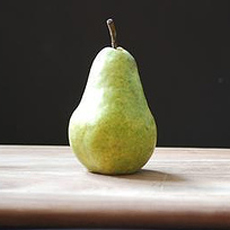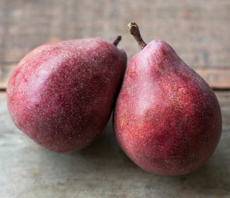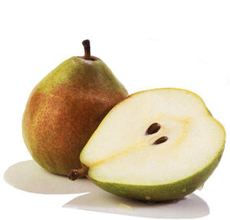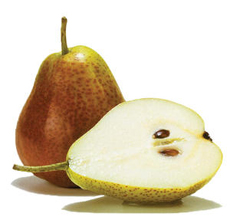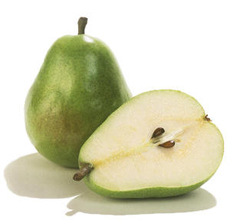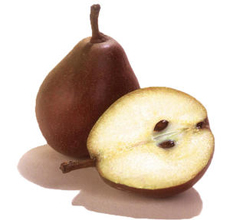RECIPE: Rose Pear Galette & The Different Types Of Pears
| Given the markup on roses for Valentine’s Day and Mother’s Day, you might want to bake your own roses. These lovely individual tarts are made from seasonal pears. (See the different types of pears, below.) If you prefer an apple rose tartlet or a vegetable rose tart, take a look at these rose pastry recipes.
December is National Pear Month. World Pear Day is the first Saturday in December. > Check below for a review of the different types of pears. Treat yourself to this elegant and refined after-dinner delight from Adrianna Adarme of A Cozy Kitchen. It’s included in her book The Year of Cozy: 125 Recipes, Crafts, and Other Homemade Adventures. Prep time is 30 minutes, and cook time is 20 to 25 minutes. Ingredients For 4 Individual Tarts For the Crust
For The Filling
For Serving
________________ *Turbinado sugar is partially refined light brown cane sugar, similar to Demerara sugar but with larger crystals. It is sold in bulk packages, and in packets as Sugar In The Raw. See the different types of sugar. Preparation 1. MIX together the flour, sugar, and salt in a large bowl. Using a box grater, grate the cold butter atop the flour mixture. Working quickly and using your hands, break the butter bits into the flour until they’re evenly distributed and resemble the size of small peas. 2. ADD 4 tablespoons of water and mix. The mixture will be shaggy at this point. From here, add 1 tablespoon of water at a time until the dough comes together (generally about 3 additional tablespoons). Flour a work surface and dump the dough onto it. Knead a few times until it comes together. Form the dough into a disk. Wrap the disk in plastic wrap and transfer it to the refrigerator to chill for at least 1 hour, or ideally overnight. 3. MIX this filling together just before the dough is ready to be removed from the fridge: In a medium bowl, toss together the pear slices, brown sugar, cocoa powder, coffee grounds, vanilla extract, and salt. 4. REMOVE the disk of dough from the refrigerator and allow it to come to room temperature for 10 minutes. Liberally flour a work surface and a rolling pin. Begin to roll the dough into a 16-inch round, being sure to rotate it every so often to avoid sticking. Using the bottom of a bowl or plate that measures about 6 inches in diameter, cut out 3 circles. Re-roll the scraps to get 1 additional circle. |
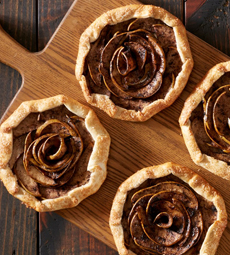 [1] Rose Pear Galette from A Cozy Kitchen | Reynolds Kitchens.
|
|
| 5. ARRANGE the pear slices neatly in a circular pattern in the center of each of the pie crust rounds, leaving about 1-1/2 inches clear at the edges. Fold over the edges to cover about 1/2 inch of the filling. Repeat with the remaining rounds. Transfer the galettes to a baking sheet lined with parchment paper and place them in the freezer to chill for 15 minutes. Meanwhile, preheat the oven to 400°F.
6. BRUSH the pie crust edges with the egg wash and sprinkle with turbinado sugar. Transfer to the oven to bake for 20 to 25 minutes, until the edges are golden brown. Check on the galettes periodically. If at any time the crusts’ edges are getting too brown, take a piece of Reynolds Wrap® Aluminum Foil and tent over the edges. When the edges are golden brown, remove them from the oven. Serve warm with a dollop of whipped cream or a scoop of your favorite vanilla ice cream. |
||
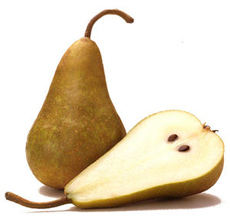 [5] Some of America’s most popular pears. Here, the Bosc pear (photos © USA Pears).
|
THE DIFFERENT TYPES OF PEARS Thanks to USA Pears for this background material. Fresh domestic pears are available year-round. Although each pear variety has its own unique properties, most can be substituted for each other in recipes. Bartlett Pears: August to February Red Bartlett Pears: August to January Bosc Pears: September to April Comice Pears: September to March Concorde Pears: September to February D’Anjou Pears: September to July Red D’Anjou Pears: September to May Forelle Pears: October to March Seckel Pears: September to February Starkrimson Pears: August to January |
|

